http://www.rhci-online.net/radiogram/radiogram.htm
RSID: <<2019-01-
http://www.rhci-online.net/radiogram/radiogram.htm
RSID: <<2019-01-
19T13:30Z MFSK-64 @ 11600000+1500>>
We had about 25 cm of snow this past week in the Washington DC
area.
It's called "snurlough," combining snow and furlough, because of
federal workers furloughed due to the US Government shutdown.
But the sledders enjoyed it ...
Sending Pic:130x120C;
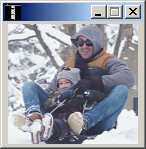
From wapo.st/2CsrA24
Please report decode to
themightykbc@gmail.com
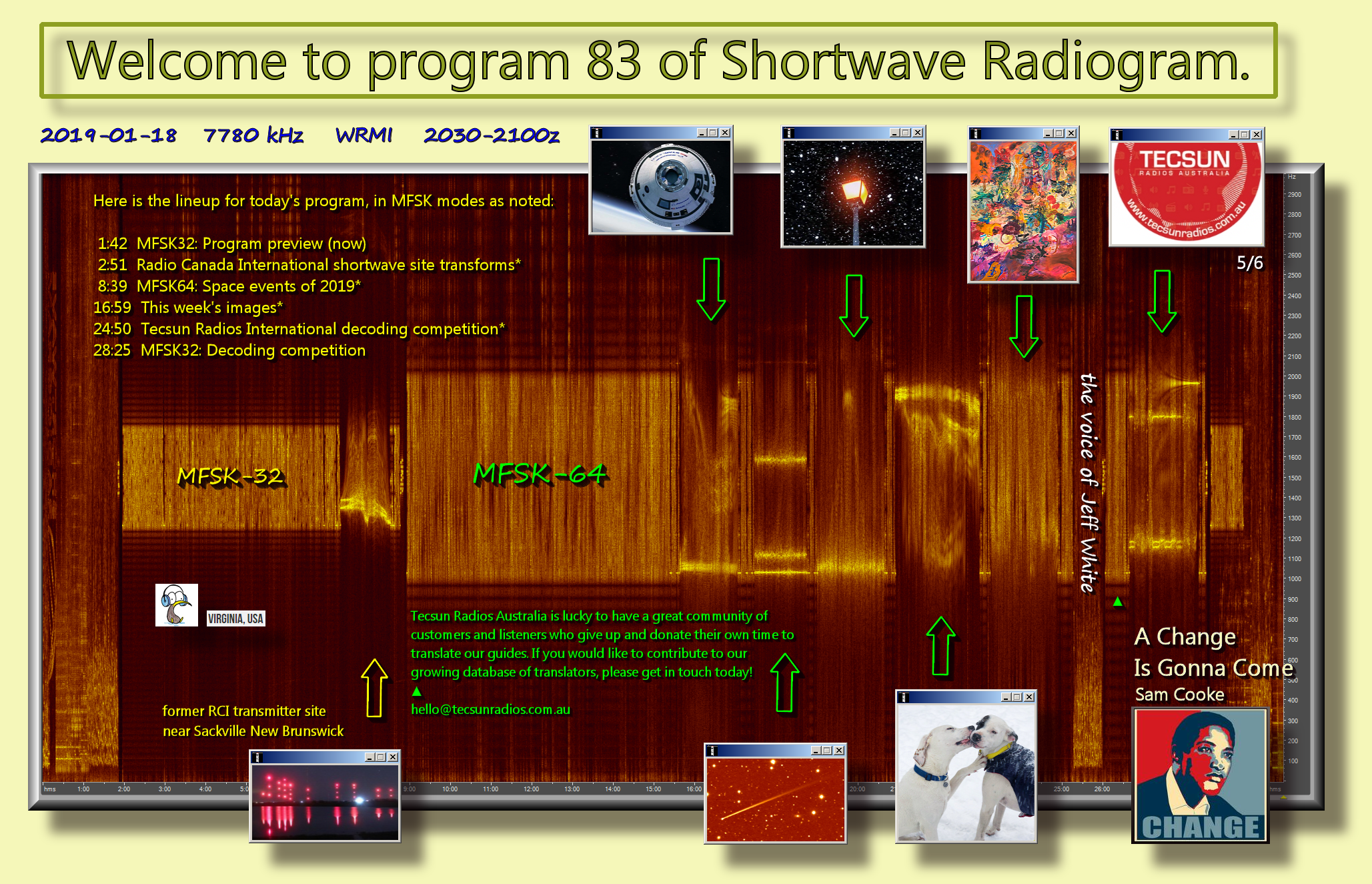
RSID: <<2019-01-18T20:31Z MFSK-32 @ 7780000+1500>>
Welcome to program 83 of Shortwave Radiogram.
I'm Kim andrew Elliott in Arlington, Virginia USA.
Here is the lineup for today's program, in MFSK modes as noted:
1:42 MFSK32: Program preview (now)
2:51 Radio Canada International shortwave site transforms*
8:39 MFSK64: Space events of 2019*
16:59 This week's images*
24:50 Tecsun Radios International decoding competition*
28:25 MFSK32: Decoding competition
* with image(s)
Please send reception reports to
radiogram@verizon.net
And visit http://swradiogram.net
Twitter:
@SWRadiogram
From Radio Canada International:
Former RCI transmitter site – slow transformation
Marc Montgomery
14 January 2019
The former RCI transmitter site near Sackville New Brunswick,
sold to a First Nations group, is now in the process of being
absorbed into native reserve land and some as yet undetermined
use.
During the Second World War as Canada was working towards
creating a shortwave service, an ideal site for the transmission
of radio signals was found in New Brunswick. Located on the
Tantramar marshes, it was ideal ground for propagation of signals
from the complex array of antenna wires and towers.
The service was ended over six decades later as a result of
severe budget cuts in 2012. The site was later purchased by
Mi'kmaq First Nations in 2017 and plans are slowly taking shape
to transform the 90 acre site into reserve land. That process
involves consultations with neighbouring municipalities, the
Royal Canadian Mounted Police, the New Brunswick provincial
government and other indigenous communities. It's expected to
take two years, during which time the Mi'kmaq will decide the use
for the land, whether cultural or economic or a combination.
The mayor of the nearby city of Sackville said he wants to work
with the Mi'kmaq, but without further indication of proposed use
of the land, it is difficult to provide a comment on positives or
negatives of any future land use by the First Nations group.
Originally designed to bring Canadian news to soldiers fighting
in Europe, the shortwave service expanded greatly during the Cold
war to bring news and information to both free European
countries, and Communist occupied states. Its role was still
further extended in later years to a world wide service to
provide information about Canada, politics, culture, scientific
advances, and business innovation.
Last year a history fan in Dorchester New Brunswick purchased the
remains of the original transmitter from the Mi'kmaq which he
hopes to display as an artefact in a museum he's created in the
old Dorchester provincial jail, we he also owns.
Quoted in a 2018 article in the Sackville Tribute, Bill Steele
said he didn't want to see the historic transmitter end up as
scrap. "It was for our troops to hear their homeland ... I'm so
proud to have saved this, I now own this, I have the 'Voice of
Canada' That's pretty cool" said Steele.
http://www.rcinet.ca/en/2019/01/14/former-rci-transmitter-site-slow-transformation/
See also:
http://www.rcinet.ca/en/2019/01/15/radio-canada-international-spectres-of-shortwave/
Image: The towers at the former RCI transmitting site in
Sackville, New Brunswick, reflected in a nearby pond, by Amanda
Dawn Christie ...
Sending Pic:219x112C;
Shortwave Radiogram now changes to MFSK64 ...
RSID: <<2019-01-18T20:38Z
MFSK-64 @
7780000+1500>>
This is Shortwave Radiogram in MFSK64
Please send your reception report to
radiogram@verizon.net
From Deutsche Welle:
What you can see in space in 2019
This year, space fans will be treated
to two lunar mission,
the Apollo 11 anniversary, some lunar
and solar eclipses,
and brand-new spacecrafts heading for
the ISS.
Dirk Lorenzen
17 January 2019
2019 will be the year of the moon. It started with Chinas Chang'e
4 mission that landed on January 3 on the far side of the moon.
No spacecraft had ever touched down on the famous "dark side,"
which isn't actually dark but which is always out of sight from
Earth. The Chang'e 4 lander and its rover will study the landing
site, measure the composition of the rocks and transmit pictures
to ground control. An instrument built by physicists at the
Christian Albrechts University in Kiel will look for traces of
water in the lunar soil.
India aims for the moon, too
In April, India will continue this year's "Moon Festival." That's
when Chandrayaan-2, the country's second lunar mission, is set to
launch. It consists of an orbiter, a lander and a rover. The
flight team wants the lander to touch down on the near side of
the moon at high southern latitudes, close to the south pole
region. India will gather experience in deep space activities,
and the scientists want to study the composition of the moon.
The highlight of this lunar year is the 50th anniversary of the
landing of Apollo 11 on the moon on July 21. Exactly half a
century ago, Neil Armstrong and Buzz Aldrin set their feet on the
lunar surface. Most space flight experts look back wistfully, as
no human being has been on the moon since the Apollo 17 mission
in December 1972. Twelve men from the US have walked on the moon.
Who will the 13th be? It could be a Chinese astronaut in about
ten years' time.
Total lunar eclipse on January 20/21
There are lots of space flight activities connected to the moon.
But the moon itself, our only natural satellite, will be an
extraordinary sight in the sky as well: There are two lunar
eclipses in 2019. The first one is a total lunar eclipse on
January 21. From 4:41 until 5:44 GMT, the moon will be completely
eclipsed by the Earth's shadow. About an hour before and one hour
after totality, the moon will be partially eclipsed.
A lunar eclipse is always visible from the regions where the moon
is above the horizon. In January, observers in most parts of
Europe, western Africa, the Americas, Greenland, the Atlantic
and the eastern Pacific Ocean will enjoy the eclipse. Since some
sunlight is bent by Earth's atmosphere into the shadow, the
eclipsed moon doesn't disappear completely. Instead, it will
still be visible in a marvelous reddish color, similar to copper.
On July 16 there will be a partial solar eclipse - 50 years to
the day after the liftoff of Apollo 11 from Cape Canaveral
towards the moon. This phenomenon will be visible in Africa, most
parts of Europe, Asia and Australia, as well as in South America,
the southern Atlantic, the Indian Ocean and Antarctica.
Three solar eclipses - but only one is total
There will even be three solar eclipses in 2019. The first was a
partial one during the night of January 5 to 6. Observers in the
far east of Russia, in north China, in Korea, Japan and the
northern Pacific were able to observe this encounter of sun and
moon.
This highlight in the skies is the only total solar eclipse on
J hith a zone extending over more than 10,000 kilometers
(6,200 miles) but only about 200 kilometers wide, day will turn
into night for 4 minutes and 38 seconds at best. During totality,
the brightest stars in the sky light up, and around the black
lunar disk, the fine bright structure of the beautiful corona is
visible - the sun's atmosphere. The narrow strip of totality
extends from the ocean east of New Zealand, across the southern
Pacific and makes landfall in Chile and ends in Argentina close
to Buenos Aires. The partial phase of this eclipse is visible
from all of South America and the southern Pacific.
Annular eclipse over south India and Singapore
The last eclipse of this year happens on December 26. It is an
annular eclipse, meaning a new moon is in front of the sun but it
is too small to cover the bright disk completely. Even at
mid-eclipse, a narrow annulus of the sun remains visible. The
partial phase is visible in most regions of Asia, in the Indian
Ocean, in the most eastern part of Africa, in Indonesia, in the
northern part of Australia and in the western Pacific. The zone
of the annular eclipse is only 100 km wide and stretches from the
Persian Gulf, over the southern part of India, Sri Lanka, the Bay
of Bengal, Sumatra, Singapore, Borneo and all the way into the
Pacific. The annular phase lasts for three and a half minutes.
Small planet, big performance: Mercury
A very special cosmic phenomenon is going to happen on November
11. The smallest and innermost planet, Mercury, will pass exactly
between sun and the Earth. For about five hours, the planet will
be visible as a small black spot crossing the bright disk of the
sun.
This event will be visible (at least in part) from Europe,
Africa, the Indian Ocean, in the Americas, large areas of the
Pacific and Antarctica. However, Mercury is so small that there
is no way to watch it with the naked eye, even if the sun's glare
is blocked by appropriate filters.
And please do pay attention! It isn't safe to observe the sun
with the unprotected eye. You always need special glasses to
block out the sun's light.
Jupiter and Saturn - planets of the year
While 2018 was a fantastic year for Mars, with the red planet
getting closer to Earth than during the previous 15 years, our
neighbour will be tough to find in 2019. Mars is in the evening
sky until April or May, however it's much fainter than it was
last year. On September 2, Mars will be right behind the Sun. In
late October, it'll reappear in the morning sky.
Jupiter, the gas giant of our solar system, will be a brilliant
planet to look at from April to September. June 10 will mark its
best visible position. Jupiter can be found in the constellation
Ophiuchus.
Saturn, the ring planet, is located in Sagittarius. On July 9, it
will in its best position to be observed. Together, Jupiter and
Saturn will be the stars of the long winter nights in the
southern hemisphere.
Venus, our inner neighbor in the solar system, starts 2019 as a
bright morning star. In June it will disappear. Then, it
re-emerges on the evening sky in October.
New US spaceships for the ISS?
2019 could see a shift in paradigm for US space flight
activities. SpaceX and Boeing will test their crew capsules for
flights to the space station (and back to Earth). SpaceX
presented its Crew Dragon almost five years ago. The - still
uncrewed - maiden flight is tentatively set for no earlier than
February.
If it performs flawlessly, and if another safety test in spring
turns out well, it could be that NASA astronauts launch from US
territory into space for the first time since the shuttle fleet
was retired in 2011. Boeing aims to get its crewed CST-100
spaceship into operation later this year.
X-ray satellite and the hunt for planets: Europe in space
After many years of delay, the Russian satellite Spektr-RG is set
to launch into space in late March. One instrument on board is
the X-ray telescope EROSITA, provided by the Max Planck Institute
for extraterrestrial physics in Garching, near Munich. EROSITA
will map the entire sky in X-rays and study the most energetic
regions in the universe, i.e. back holes.
In October, the European Space Agency wants to launch its CHEOPS
mission. This space telescope will provide unique data about
planets orbiting other stars. The ESA team will characterize
rocky planets and determine their size and density in order to
select candidates for the future search for life in space.
Few shooting stars – and no James Webb launch
Stargazers will be disappointed by this year's meteor showers.
The three major ones, the Perseids from August 10 to 14, the
Leonids from November 14 to 16 and the Geminids from December 11
to 15 are spoiled by the light of a bright moon in the sky. Only
the brightest meteors will be visible under these bad viewing
conditions.
The biggest disappointment, however, is the shift in the launch
date of the James Webb space telescope, which is a sort of
successor to the the Hubble Space Telescope that NASA and ESA
want to put into space well beyond the moon. That launch was
delayed by another two years to 2021.
https://www.dw.com/en/what-you-can-see-in-space-in-2019/a-46992783
Image: Boeing's CST-100 Starliner, along with SpaceX's Dragon,
might bring astronauts to the ISS this year ...
Sending Pic:208x137C;
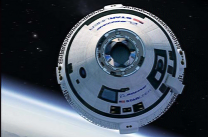
This is Shortwave Radiogram in MFSK64
Please send your reception report to
radiogram@verizon.net
Images of the week ...
Asteroid (6478) Gault has developed a tail. From
cnet.co/2FHhPk4
...
Sending Pic:206x124C;
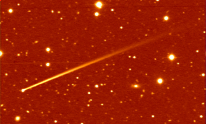
A scene from last weekend's snowfall in the Washington DC area.
From bit.ly/2DhXfFb ...
Sending Pic:209x157C;
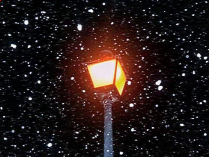
From the same snowstorm, "Snow date at the Columbia Heights Dog
Park" in Washington DC. From bit.ly/2Fz3uaa
...
Sending Pic:204x203C;

Our painting of the week is by Jack Whitten. From
wapo.st/2Hv2m9l
...
Sending Pic:159x209C;

RSID: <<2019-01-18T20:55Z
MFSK-64 @
7780000+1500>>
Ending song SWRG:
https://www.midomi.com/index.php?action=main.track&track_id=100096590407192707&from=voice_search
Sam Cooke - A Change
Is Gonna Come
https://www.youtube.com/watch?v=wEBlaMOmKV4
http://www.rhci-online.net/radiogram/radiogram.htm
QTH:
D-06193 Petersberg (Germany/Germania)
Ant.: Dipol
for 40m-Band & Boomerang
Antenna 11m-Band RX
for RF: FRG-100B
+ IF-mixer &
ICOM IC-R75 + IF-mixer
Software IF: con
STUDIO1 - Software italiano per SDR [S-AM-USB/LSB]
+
beta 11 Version 2.80 (August 21, 2018)
- for scheduled IF-recording
Software AF: Fldigi-4.0.18
+
flmsg-4.0.7
images-fldigifiles on homedrive.lnk OS:
German XP-SP3 with support for asian languages
German W7 32bit + 64bit
PC: MEDION
Titanium 8008 (since 2003) [ P4 - 2,6 GHz]
MSI-CR70-2MP345W7
(since2014) [i5 -P3560 ( 2
x 2,6GHz) ]
Next on Shortwave Radiogram, you will hear the voice of Jeff
White with information about the Tecsun Radios Australia image
decoding competition. That will be followed by more information
in MFSK64, and after that the fifth of six images in the
competition.
https://www.tecsunradios.com.au/store/decodetowin-a-tecsun-pl880/
Want to learn more about shortwave radio? Tecsun Radios Australia
offers comprehensive user guides for our customers around the
world in English and other languages such as French! We believe
everyone should be able to enjoy listening to the radio and many
of our guides have even been re-purposed for sight-impaired
users!
Tecsun Radios Australia is lucky to have a great community of
customers and listeners who give up and donate their own time to
translate our guides. If you would like to contribute to our
growing database of translators, please get in touch today!
hello@tecsunradios.com.au
www.tecsunradios.com.au
Sending Pic:225x152C;

Shortwave Radiogram now returns to MFSK32 ...
RSID: <<2019-01-18T20:58Z
MFSK-32 @
7780000+1500>>
This is Shortwave Radiogram in MFSK32 ...
Transmission of Shortwave Radiogram is provided by:
WRMI, Radio Miami International, http://wrmi.net
WINB Shortwave, http://www.winb.com/
and
Space Line, Bulgaria, http://spaceline.bg
Please send reception reports to
radiogram@verizon.net
And visit http://swradiogram.net
Twitter:
@SWRadiogram
I'm Kim Elliott. Please join us for the next Shortwave
Radiogram.
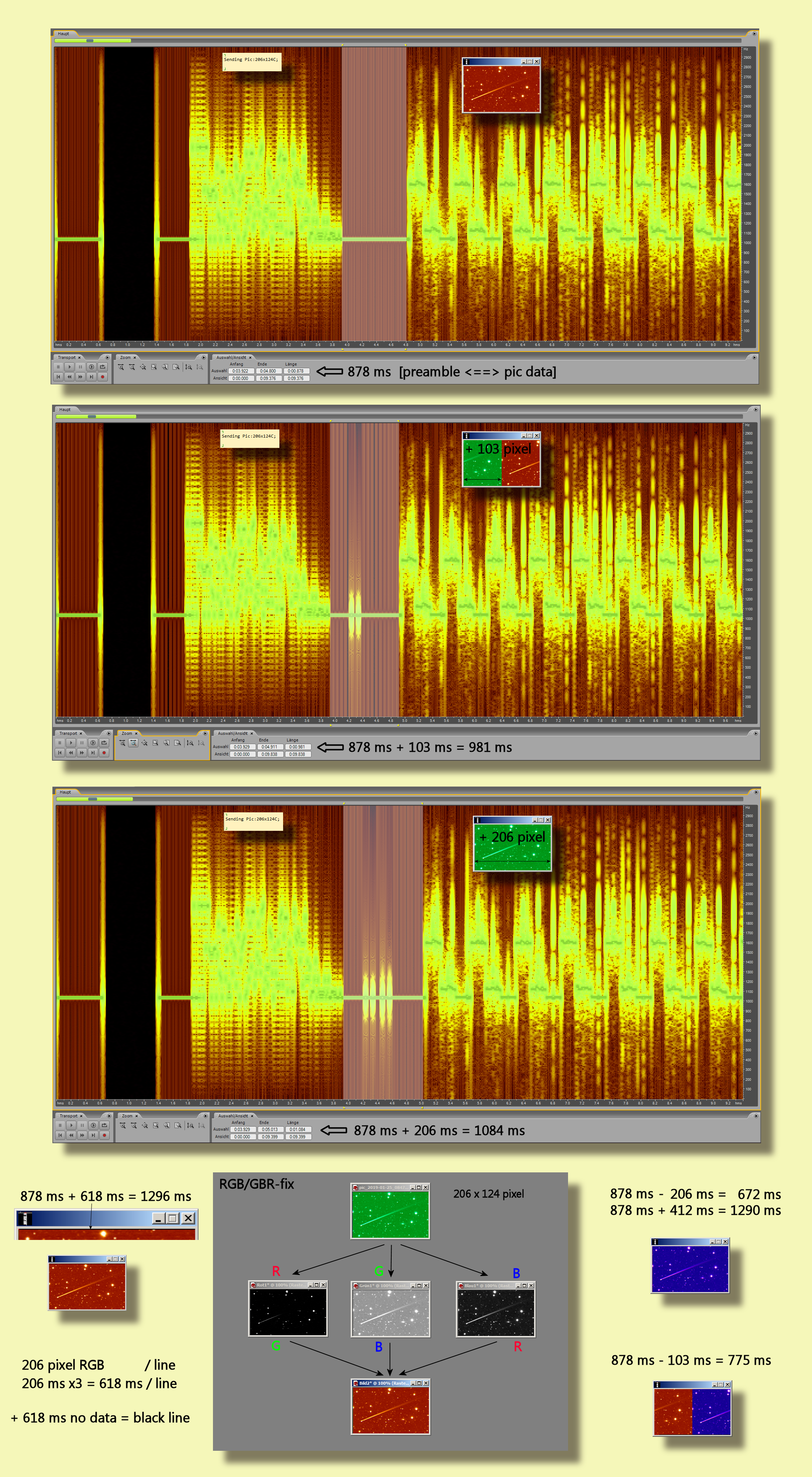

RSID: <<2019-01-19T13:03Z
MFSK-32 @
6070000+1500>>
RSID: <<2019-01-19T13:03Z
MFSK-32 @
6070000+1500>>
Slow Scan Radio January 19th, 2019, Episode 22
Good afternoon to everyone listening.
Today we will have between 10 and 12 SSTV images and two images in DRM.
You can receive the DRM images using a recent version of QSSTV when using Linux.
EasyPal can be used under Windows. But some mention results being not good. A
better alternative might probably be WinDRM, which appears not being avalable
for download at this moment. Preferably use QSSTV if you can.
To separate SSTV and DRM, today we will send a few characters in morse code, so
that you know you have to switch.
We had some response on our experiments with DRM, both via mail and on Twitter.
Last two shows we took almost the worst possible settings of the DRM software
for HF us. Thanks to those listener comments this week we will have two settings
that will probably work, at
least one of the two. Let's say it is a learning proces :-)
This info will be in MFSK32. After that we will repeat this text in several
other modes.
Info on the show:
Mail: x@xdv.me
Web: www.slowscanradio.com
Mastodon: @PA0ETE@wokka.be
Twitter: SlowScanRadio
Slow Scan Radio is sponsored by 70MHzshop.nl
de k
RSID: <<2019-01-19T13:05Z
20xPSK63R @
6070000+1500>>
RSID: <<2019-01-19T13:05Z
20xPSK63R @
6070000+1500>>
Slow Scan Radio January 19th, 2019,
Episode 22
Good afternoon to everyone listening.
Today we will have between 10 and 12 SSTV images and two images in DRM.
You can receive the DRM images using a recent version of QSSTV when using Linux.
EasyPal can be used under Windows. But some mention results being not good. A
better alternative might probably be WinDRM, which appears not being avalable
for download at this moment. Preferably use QSSTV if you can.
To separate SSTV and DRM, today we will send a few characters in morse code, so
that you know you have to switch.
We had some response on our experiments with DRM, both via mail and on Twitter.
Last two shows we took almost the worst possible settings of the DRM software
for HF use. Thanks to those listener comments this week we will have two
settings that will probably work, at
least one of the two. Let's say it is a learning proces :-)
This info will be in MFSK32. After that we will repeat this text in several
other modes.
Info on the show:
Mail: x@xdv.me
Web: www.slowscanradio.com
Mastodon: @PA0ETE@wokka.be
Twitter: SlowScanRadio
Slow Scan Radio is sponsored by 70MHzshop.nl
de k
https://en.wikipedia.org/wiki/Mechanical_television
https://upload.wikimedia.org/wikipedia/commons/9/97/Family_watching_television_1958.jpg
https://en.wikipedia.org/wiki/Philips_PM5544
https://de.wikipedia.org/wiki/Narrow_Bandwidth_Television
https://www.youtube.com/watch?v=1ShYefsbnAE&feature=share
https://c1.staticflickr.com/9/8353/29496693905_f04c498fa1_b.jpg
https://www.flickr.com/photos/ylearkisto/29496693905
.jpg)
https://de.wikipedia.org/wiki/Testbild#Analoges_Testbild_(FuBK-Testbild)
Braun HF 1, 1958
http://66.media.tumblr.com/tumblr_l0hl2kTgbI1qzbqc0o1_1280.jpg
https://de.wikipedia.org/wiki/Fernsehger%C3%A4t
Fernsehstandgerät FER858A „Clivia“
VEB Rafena-Werke Radeberg, DDR 1956
.jpg)
https://upload.wikimedia.org/wikipedia/commons/e/ec/Fernseher.jpg
https://de.wikipedia.org/wiki/Fernsehger%C3%A4t
https://de.wikipedia.org/wiki/Datei:Exotic_dancer_on_hands_and_knees.jpg
https://upload.wikimedia.org/wikipedia/commons/1/1c/Exotic_dancer_on_hands_and_knees.jpg

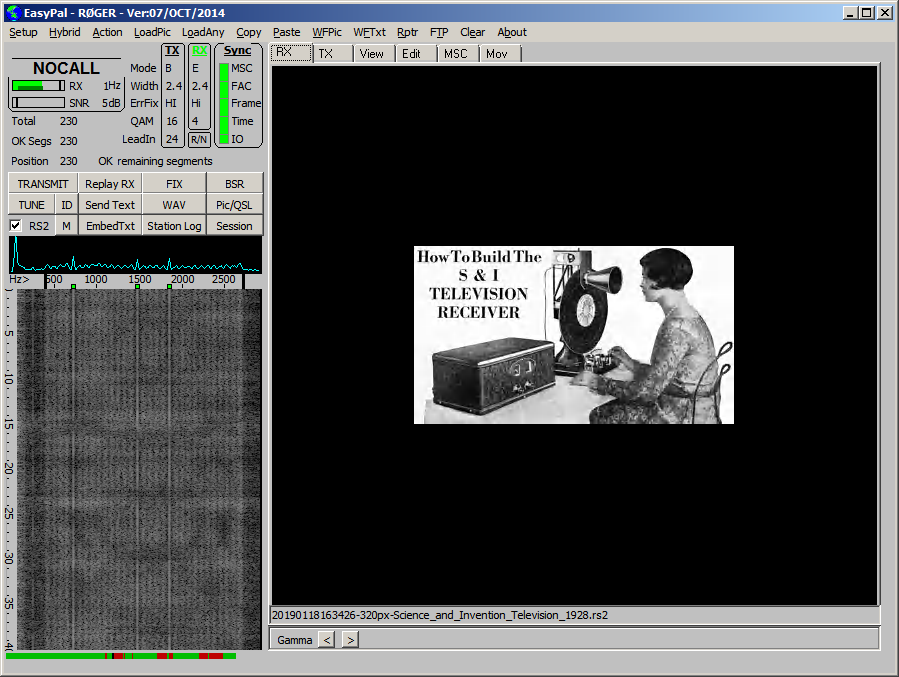
RSID: <<2019-01-19T13:27Z Feld Hell @ 6070000+1500>>

RSID: <<2019-01-19T13:28Z 20xPSK63R @ 6070000+1500>>
RSID: <<2019-01-19T13:28Z 8PSK1000 @ 6070000+1500>>
RSID: <<2019-01-19T13:28Z 8PSK500 @ 6070000+1500>>
RSID: <<2019-01-19T13:28Z 8PSK250 @ 6070000+1500>>
RSID: <<2019-01-19T13:28Z 8PSK125 @ 6070000+1500>>
RSID: <<2019-01-19T13:28Z 32PSK63R @ 6070000+1500>>
RSID: <<2019-01-19T13:28Z DominoEX88 @ 6070000+1500>>
RSID: <<2019-01-19T13:28Z DominoEX16 @ 6070000+1500>>
www.slowscanradio.com - x@xdv.me -
Slow Scan Radio is sponsored by 70MHzshop.nl - Mastodon: @PA0ETE@wokka.be -
Twitter: SlowScanRadio
de k